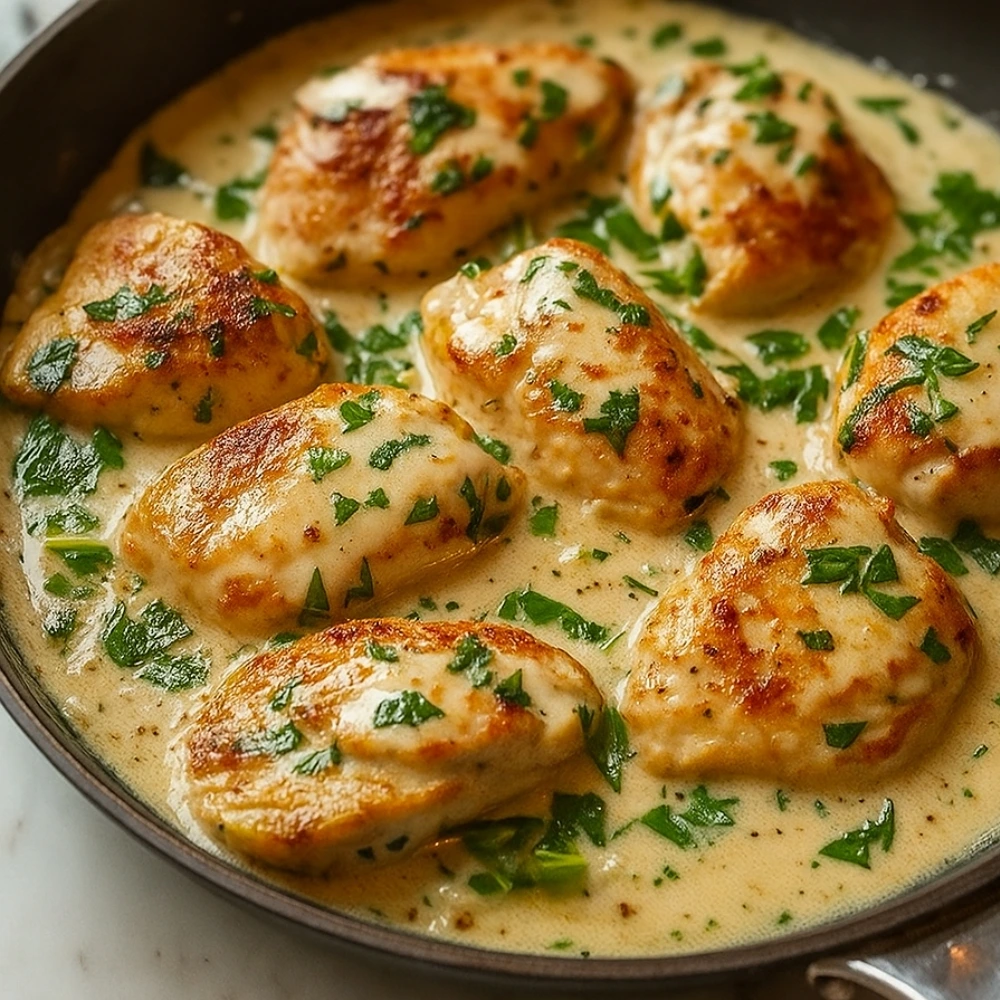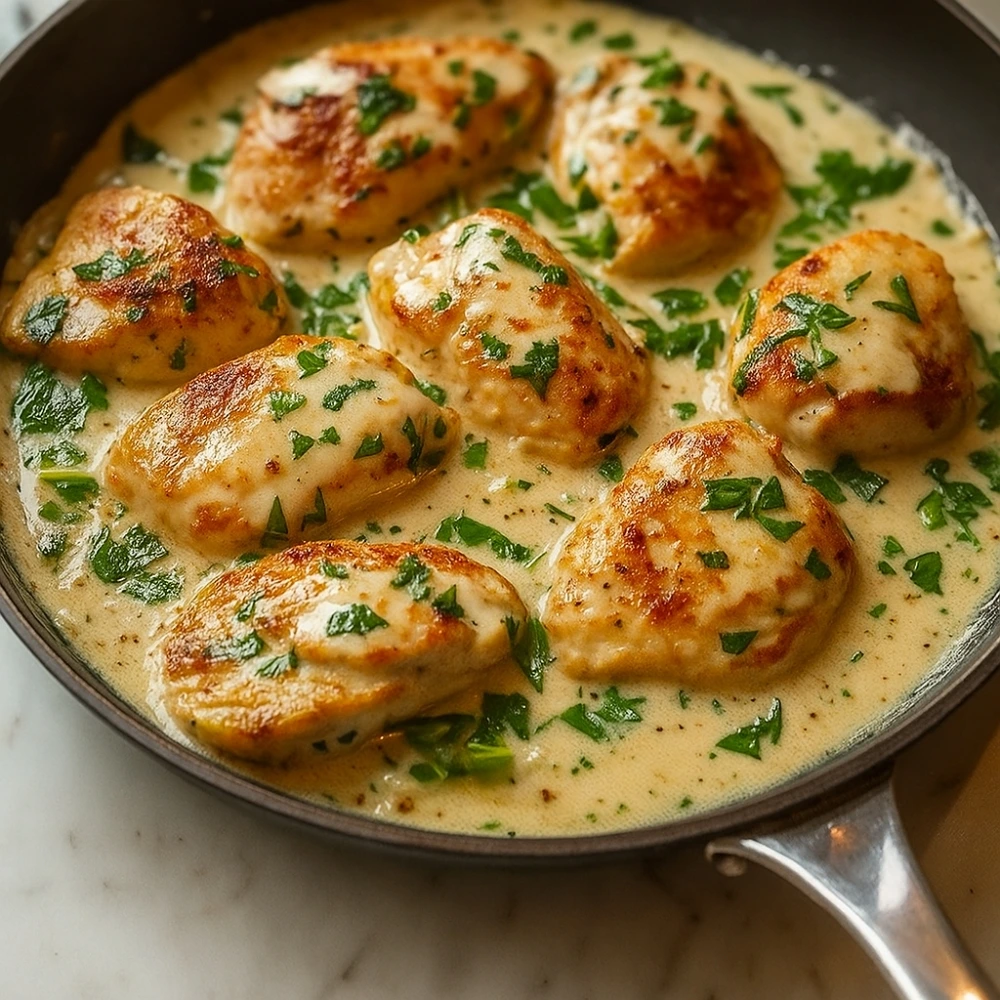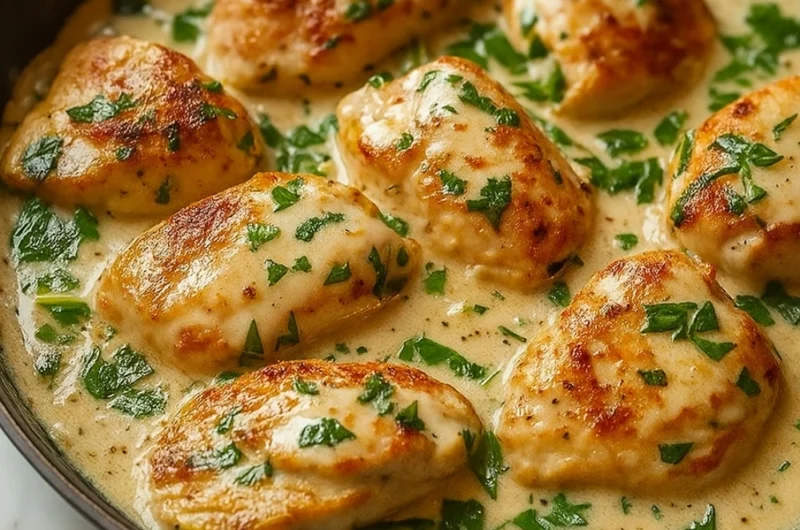The Best Fluffy Pancakes recipe you will fall in love with. Full of tips and tricks to help you make the best pancakes.
Creamy Chicken Florentine: Your Perfect 30-Minute Guide

Are you tired of dry, flavorless chicken dinners? Picture this instead: tender, juicy chicken breasts nestled in a velvety, garlicky cream sauce with vibrant spinach—a restaurant-quality meal that takes just 30 minutes from start to finish. This Chicken Florentine recipe guarantees perfectly cooked chicken and a rich, luxurious sauce every single time, thanks to a few professional techniques that make all the difference.
What sets our creamy Chicken Florentine apart? We’ve perfected the searing method to lock in moisture, created a foolproof cream sauce that never separates, and incorporated pro tips at every step to ensure your success. Whether you’re a beginner or an experienced home cook, this guide will walk you through everything you need to master this Italian-inspired classic.
Why This Chicken Florentine Recipe Works
This isn’t just another chicken recipe—it’s a carefully engineered approach to achieving perfection:
- The Perfect Sear: Our temperature control technique ensures golden-brown chicken with a restaurant-quality crust while staying incredibly juicy inside
- Balanced Cream Sauce: The ratio of cream, broth, and Parmesan creates a silky sauce that coats every bite without being heavy
- Fresh Spinach Integration: Timing is everything—we add spinach at precisely the right moment to maintain its vibrant color and nutrients
- One-Pan Wonder: Everything cooks in a single skillet, building layers of flavor while minimizing cleanup
“The secret to authentic Italian cooking isn’t complexity—it’s understanding how simple ingredients work together harmoniously.” — Traditional Italian Culinary Wisdom
Ingredients You’ll Need
For the Chicken:
- 4 boneless, skinless chicken breasts (6-8 oz each, pounded to even thickness)
- 2 tablespoons olive oil (for searing)
- Salt and freshly ground black pepper (to taste)
- 1 teaspoon Italian seasoning
- ½ teaspoon garlic powder
For the Creamy Florentine Sauce:
- 3 tablespoons butter (divided)
- 4 cloves garlic (minced)
- 1 cup chicken broth (low-sodium recommended)
- 1½ cups heavy cream
- ½ cup freshly grated Parmesan cheese
- 5 oz fresh baby spinach (approximately 5 packed cups)
- 1 teaspoon dried basil (or 1 tablespoon fresh)
- ½ teaspoon red pepper flakes (optional, for heat)
- Juice of ½ lemon (brightens the sauce)
Equipment Needed:
- Large 12-inch skillet (preferably stainless steel or cast iron)
- Meat mallet or rolling pin
- Tongs
- Whisk
- Measuring cups and spoons
Ingredient Deep Dive: Quality Matters
Choosing Your Chicken
Fresh vs. Frozen: Fresh chicken breasts provide the best texture, but high-quality frozen chicken works perfectly if properly thawed in the refrigerator overnight. Look for chicken that’s plump and pinkish in color without any gray spots.
Size Consistency: Select chicken breasts that are similar in size (6-8 oz each) so they cook evenly. Pounding them to an even ¾-inch thickness is crucial—this prevents the thin ends from drying out while the thick parts finish cooking.
Spinach Selection
Fresh is Best: For this chicken Florentine recipe, fresh baby spinach is highly recommended. It wilts beautifully and maintains a vibrant green color that frozen spinach simply can’t match.
Can I Use Frozen Spinach? Absolutely! If using frozen, thaw completely and squeeze out ALL excess moisture using a clean kitchen towel. You’ll need about 10 oz frozen spinach (once thawed and drained) to replace 5 oz fresh. Add it slightly earlier in the cooking process.
Cream Options
Heavy Cream: This creates the authentic, luxurious texture. Don’t substitute with milk—it will curdle.
Half-and-Half: Can work in a pinch but will produce a thinner sauce. Add 1 tablespoon of flour whisked into the butter to help thicken.
<a id=”recipe-card”></a>Step-by-Step Instructions: Mastering Chicken Florentine
Prep Time: 10 minutes | Cook Time: 20 minutes | Total Time: 30 minutes
Servings: 4 | Difficulty: Easy | Course: Main Course | Cuisine: Italian-American
Step 1: Prepare the Chicken (5 minutes)
Pat the chicken breasts completely dry with paper towels—this is essential for achieving a golden sear. Place each breast between two sheets of plastic wrap or parchment paper and gently pound to an even ¾-inch thickness using a meat mallet.
Season both sides generously with salt, pepper, Italian seasoning, and garlic powder.
Pro Tip: Don’t skip the pounding step! Even thickness means even cooking, which is the difference between juicy chicken and dry, overcooked edges.
Step 2: Sear the Chicken (8-10 minutes)
Heat olive oil in your large skillet over medium-high heat until it shimmers (but doesn’t smoke). Carefully add the chicken breasts, leaving at least 1 inch of space between each piece.
Sear without moving for 5-6 minutes on the first side until a golden-brown crust forms. Flip and cook for another 4-5 minutes until the internal temperature reaches 160°F (it will climb to 165°F as it rests).
Transfer chicken to a plate and tent loosely with foil.
Pro Tip: Don’t overcrowd the pan! Cook in batches if necessary. Overcrowding causes steaming instead of searing, resulting in pale, rubbery chicken. The pan needs to be hot enough that the chicken sizzles immediately upon contact.
Why It Works: Searing creates a flavorful crust through the Maillard reaction while sealing in juices. Removing the chicken before it hits 165°F prevents overcooking, as carryover heat will finish the job.
Step 3: Build Your Flavor Base (2 minutes)
Reduce heat to medium and add 2 tablespoons of butter to the same skillet. As it melts, use a wooden spoon to scrape up all those beautiful browned bits (fond) stuck to the bottom—this is pure flavor gold.
Add minced garlic and sauté for 45-60 seconds until fragrant but not browned.
Pro Tip: Watch garlic carefully—it can burn in seconds and turn bitter. If it starts browning too quickly, remove the pan from heat momentarily.
Why It Works: Deglazing the pan captures all the concentrated chicken flavors, creating a more complex sauce base.
Step 4: Create the Creamy Sauce (3-4 minutes)
Pour in the chicken broth and bring to a gentle simmer, scraping any remaining fond from the pan. Let it reduce by about one-third (2-3 minutes) to concentrate the flavors.
Lower the heat to medium-low and stir in the heavy cream. Allow it to gently simmer (don’t boil) for 2 minutes, stirring occasionally.
Whisk in the Parmesan cheese, dried basil, and red pepper flakes if using. The sauce should coat the back of a spoon.
Pro Tip: Never let the cream boil vigorously—high heat can cause it to separate or curdle. A gentle simmer is perfect. If your sauce seems thin, let it reduce another 1-2 minutes. Too thick? Add a splash of broth.
Why It Works: Reducing the broth first intensifies its flavor, while gradually incorporating cream at a lower temperature prevents curdling and creates a silky-smooth texture.
Step 5: Wilt the Spinach (2 minutes)
Add the fresh spinach in batches, stirring gently as each addition wilts down (it reduces dramatically—don’t worry!). Once all spinach is incorporated and wilted, taste and adjust seasoning with salt, pepper, and a squeeze of fresh lemon juice.
Pro Tip: Add spinach in 2-3 batches rather than all at once. This helps it wilt evenly and prevents overwhelming the pan. The lemon juice at the end is optional but highly recommended—it brightens the rich sauce and balances the cream.
Step 6: Bring It All Together (2 minutes)
Return the seared chicken breasts (and any accumulated juices) to the skillet, nestling them into the creamy spinach sauce. Spoon sauce over the top of each piece.
Simmer gently for 1-2 minutes to reheat the chicken and allow the flavors to meld. Check that the internal temperature reaches 165°F.
Pro Tip: Don’t overcook at this stage! The chicken is already mostly cooked—you’re just warming it through and infusing it with the sauce.

Pro Tips & Troubleshooting: Mastering Your Florentine
Common Mistakes & How to Fix Them
Problem: My chicken is dry and overcooked
- Solution: Use an instant-read thermometer and remove chicken at 160°F. Carryover cooking will bring it to safe 165°F. Also, pounding to even thickness is crucial.
Problem: My sauce is too thin
- Solution: Let it simmer uncovered for 2-3 more minutes to reduce. Alternatively, mix 1 teaspoon cornstarch with 1 tablespoon cold water and whisk into the sauce.
Problem: My sauce is too thick or separating
- Solution: Thin with chicken broth, 1 tablespoon at a time. If separating, you boiled it too hard—reduce heat immediately and whisk vigorously. A splash of cream can help re-emulsify.
Problem: The garlic burned and tastes bitter
- Solution: Prevention is key—add garlic to medium (not high) heat and watch carefully. If it burns, you’ll need to start the sauce over with fresh garlic.
Advanced Tips for Perfection
- Room Temperature Chicken: Let chicken sit out for 15-20 minutes before cooking for more even searing
- Pan Temperature Test: The oil is ready when a drop of water sizzles immediately
- Fresh Parmesan Only: Pre-shredded cheese contains anti-caking agents that prevent smooth melting
- Sun-Dried Tomato Upgrade: Add 2-3 tablespoons of chopped sun-dried tomatoes with the garlic for extra depth
- Wine Deglazing: Replace half the chicken broth with dry white wine for restaurant-level sophistication
Delicious Chicken Florentine Variations
Spicy Chicken Florentine
Increase red pepper flakes to 1 teaspoon and add ½ teaspoon smoked paprika. Finish with a drizzle of hot honey over the plated chicken.
Mushroom Florentine
Sauté 8 oz sliced mushrooms (cremini or button) after cooking the chicken and before adding garlic. This earthy addition complements the cream sauce beautifully.
Chicken Florentine Pasta
Toss the finished sauce with 12 oz cooked fettuccine, penne, or bow-tie pasta. Slice the chicken and arrange on top. This makes the recipe stretch to 6 servings.
Healthy Chicken Florentine Options
- Lower Calorie: Replace half the heavy cream with unsweetened almond milk or cashew milk thickened with 1 tablespoon flour
- Dairy-Free: Use full-fat coconut cream and nutritional yeast instead of Parmesan
- Gluten-Free: This recipe is naturally gluten-free! Just ensure your chicken broth is certified GF
- Keto-Friendly: This recipe is already low-carb perfection—3g net carbs per serving
Chicken Florentine Bake
Transfer the sauced chicken to a baking dish, top with ½ cup mozzarella, and broil for 2-3 minutes until bubbly and golden. Perfect for meal prep!
Serving Suggestions & Wine Pairings
What to Serve with Chicken Florentine
This creamy chicken dish pairs beautifully with:
| Side Dish | Why It Works |
|---|---|
| Garlic Mashed Potatoes | Soaks up the luxurious sauce perfectly |
| Pasta (Fettuccine or Angel Hair) | Classic pairing for creamy Italian sauces |
| Risotto | Creamy on creamy—an indulgent treat |
| Crusty Bread | Essential for sauce-mopping |
| Roasted Asparagus | Adds freshness and crunch |
| Caesar Salad | Classic Italian restaurant experience |
| Wild Rice Pilaf | Nutty flavor complements the cream |
Perfect Wine Pairings
White Wines:
- Chardonnay (lightly oaked): Complements the cream sauce’s richness
- Pinot Grigio: Crisp acidity cuts through the butter and cream
- Sauvignon Blanc: Bright, herbaceous notes echo the spinach
Red Wines (for adventurous palates):
- Light Pinot Noir: Won’t overwhelm the delicate chicken while adding depth
Storage & Reheating Instructions
Refrigerator Storage
Store leftover Chicken Florentine in an airtight container for up to 3 days. Keep the chicken and sauce together to prevent the chicken from drying out.
Freezing
While possible, cream sauces can separate when frozen. If you plan to freeze:
- Cool completely
- Store in freezer-safe containers for up to 2 months
- Thaw overnight in the refrigerator
- Reheat gently, whisking in 2-3 tablespoons fresh cream to restore texture
Reheating Tips
Stovetop Method (Best): Reheat in a covered skillet over medium-low heat, adding 2-3 tablespoons of chicken broth or cream to loosen the sauce. Stir gently until heated through (165°F).
Microwave Method: Place in a microwave-safe dish, cover with a damp paper towel, and heat in 1-minute intervals at 70% power, stirring between intervals.
The Story of “Florentine”
Ever wonder why so many dishes feature the name “Florentine”? This culinary term has its roots in Renaissance-era Florence, Italy, where dishes prepared alla Florentina traditionally featured spinach as a key ingredient. Legend has it that this style was popularized by Catherine de’ Medici, the Florentine noblewoman who became Queen of France in 1547.
When Catherine moved to France, she brought her Italian chefs and their love of spinach, introducing the ingredient to French haute cuisine. Today, any dish labeled “Florentine”—whether it’s Chicken Florentine, Eggs Florentine, or Fish Florentine—pays homage to this rich culinary heritage by featuring spinach alongside cream, often with Parmesan cheese.
Our creamy Chicken Florentine recipe honors this tradition while making it accessible for modern home cooks seeking a quick weeknight dinner that doesn’t sacrifice flavor or elegance.
Frequently Asked Questions
Can I use chicken thighs instead of breasts?
Absolutely! Boneless, skinless thighs work wonderfully and stay even more moist. Increase cooking time by 2-3 minutes and ensure internal temperature reaches 165°F.
How do I make this recipe ahead for entertaining?
Sear the chicken and prepare the sauce separately up to 1 day ahead. Store refrigerated. When ready to serve, reheat sauce gently, add spinach, then add chicken and warm through.
What’s the best substitute for heavy cream?
Full-fat coconut cream provides similar richness (dairy-free!). Greek yogurt mixed with a little milk can work but add it off-heat to prevent curdling.
Can I double this recipe?
Yes, but cook the chicken in batches to avoid overcrowding. You can prepare all the sauce at once in a larger skillet.
Try This Recipe Today!
There you have it—everything you need to create restaurant-quality Chicken Florentine in your own kitchen. This easy chicken Florentine brings together tender, perfectly cooked chicken with a rich, creamy spinach sauce that will have everyone asking for seconds.
Ready to make dinner unforgettable? Try this recipe tonight and discover why it’s become a weeknight staple in thousands of homes. The combination of simple ingredients, foolproof techniques, and incredible flavor makes this Italian chicken dish a true winner.
We’d love to hear from you! After you make this creamy Chicken Florentine recipe, leave a comment below with your results. Did you try any of the variations? What did you serve alongside it? Share your photos on social media and tag us—we feature our favorite recreations!
Want more delicious Italian-inspired recipes delivered straight to your inbox? Sign up for our newsletter and never miss a new recipe, cooking tip, or kitchen hack. Your next favorite dinner is just one click away!
Creamy Chicken Florentine: Your Perfect 30-Minute Guide
Course: DinnerCuisine: Italian4
servings15
minutes25
minutes420
kcalIngredients
4 boneless, skinless chicken breasts
2 tablespoons olive oil (or butter)
Salt and black pepper, to taste
3 cloves garlic, minced
1 cup heavy cream
½ cup chicken broth
½ cup grated Parmesan cheese
1 teaspoon Italian seasoning
2 cups fresh spinach leaves
1 tablespoon lemon juice (optional, for brightness)
Directions
- Season & Sear Chicken
- Pat chicken breasts dry and season with salt and pepper.
- Heat olive oil in a skillet over medium-high heat.
- Sear chicken 4–5 minutes per side until golden brown. Remove and set aside.
- Prepare Creamy Sauce
- In the same skillet, add garlic and sauté until fragrant.
- Pour in chicken broth and heavy cream, stirring well.
- Add Parmesan cheese and Italian seasoning, whisking until smooth.
- Add Spinach
- Stir in fresh spinach and cook until wilted.
- Adjust seasoning with salt, pepper, and lemon juice if desired.
- Finish Chicken
- Return chicken breasts to the skillet, spoon sauce over them.
- Simmer 5–7 minutes until chicken is cooked through (internal temp 165°F / 74°C).
- Serve
- Plate chicken with plenty of sauce and spinach.
- Serve over pasta, rice, or with crusty bread.

